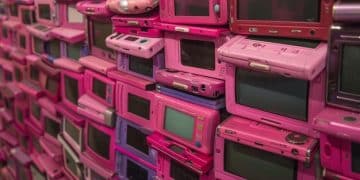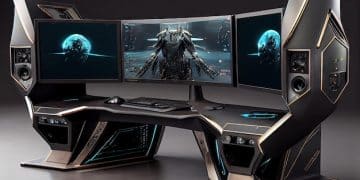Backward Compatibility in 2025: Reliving Classic Games on Modern Consoles
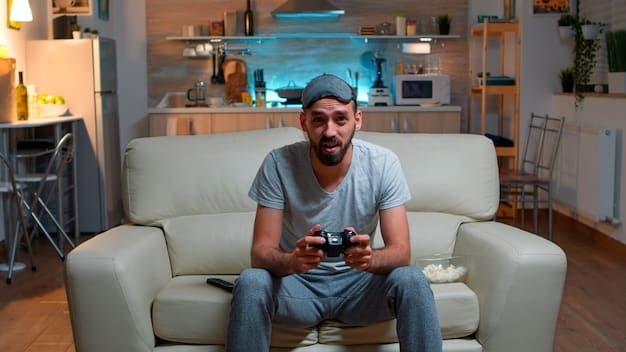
Backward Compatibility on Consoles in 2025 allows gamers to enjoy classic titles on modern hardware, preserving gaming history and offering convenient access to beloved games without needing older systems.
Get ready to dust off your digital library! Backward Compatibility on Consoles in 2025 is set to revolutionize how we experience gaming, blending nostalgia with cutting-edge technology. Are you ready to journey back to your favorite classics?
The Evolution of Backward Compatibility
Backward compatibility has come a long way since its initial implementation. Understanding its evolution helps appreciate its significance in modern gaming.
From simple software emulation to sophisticated hardware integration, the journey of backward compatibility is a testament to the gaming industry’s commitment to preserving its history. Let’s explore the key milestones.
Early Implementations
The earliest attempts at backward compatibility were often limited. Consoles like the Atari Flashback offered simple emulations, but lacked the full functionality of original hardware.
Modern Approaches
Modern consoles take a more comprehensive approach. The Xbox Series X, for example, uses both software emulation and hardware enhancements to ensure classic games run smoothly.
- Software Emulation: Simulates the original hardware environment.
- Hardware Enhancements: Uses modern hardware to improve resolution and frame rates.
- Game Preservation: Allows players to access and enjoy classic titles without needing original systems.
Backward compatibility not only benefits gamers but also extends the lifespan of beloved titles, ensuring they remain accessible for future generations. By understanding its past, we can better appreciate its potential in 2025.
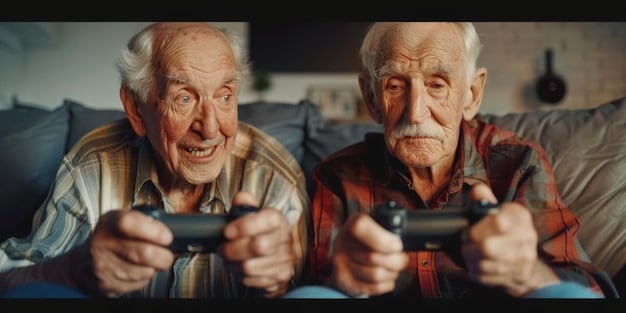
In conclusion, the evolution of backward compatibility reflects the gaming industry’s dedication to blending old and new, offering players a seamless and enhanced gaming experience.
Why Backward Compatibility Matters in 2025
In 2025, backward compatibility is more than just playing old games. It represents a commitment to preserving gaming history and offering value to consumers.
With the rise of digital distribution and subscription services, backward compatibility is becoming a standard expectation. Here’s why it’s so crucial.
Preserving Gaming History
Backward compatibility ensures that classic games are not lost to time, allowing future generations to experience and appreciate the roots of modern gaming.
Economic Value
For gamers, backward compatibility means not having to repurchase games they already own. It adds tremendous value to modern consoles and encourages continued engagement.
- Cost Savings: Players don’t need to buy multiple consoles to play their favorite games.
- Convenience: Everything is accessible on a single device.
- Extensive Library: Access to a vast collection of both new and classic titles.
Backward compatibility also benefits developers by extending the lifespan of their games and creating opportunities for remasters and re-releases. It’s a win-win for everyone involved.
Ultimately, the importance of backward compatibility in 2025 lies in its ability to honor gaming history, provide economic value, and enhance the overall gaming experience.
The Technical Challenges of Emulation
Emulating older systems on modern hardware is no easy feat. Various technical hurdles must be overcome to ensure accurate and smooth gameplay.
From differences in processor architecture to handling legacy input methods, the technical challenges are significant. Let’s explore some key areas.
Processor Architecture
Older consoles often used processors with vastly different architectures than modern systems. Emulating these processors requires complex software and significant processing power.
Input Methods
Replicating the feel of older controllers on modern systems can be difficult. Ensuring accurate input mapping and low latency is crucial for a good gaming experience.
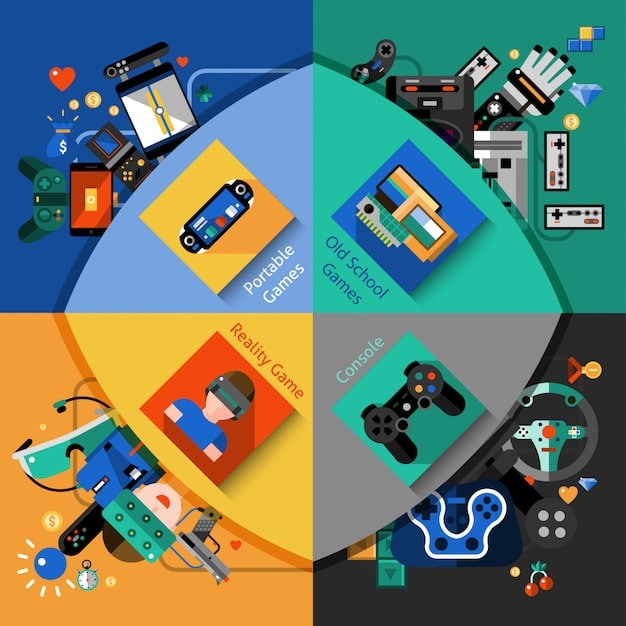
Addressing these technical challenges requires ongoing innovation in both hardware and software. As emulation technology improves, backward compatibility becomes more viable and seamless.
In conclusion, while emulation presents significant technical challenges, advancements in hardware and software continue to make it a more effective solution for backward compatibility.
The Role of Cloud Gaming in Backward Compatibility
Cloud gaming offers a new avenue for backward compatibility by streaming classic games to modern devices. This approach bypasses many of the traditional emulation challenges.
Services like PlayStation Now and Xbox Cloud Gaming leverage cloud technology to provide access to extensive libraries of classic games. Here’s how it works.
How Cloud Gaming Works
Games are hosted on remote servers and streamed to the player’s device, eliminating the need for local hardware emulation. This allows even low-powered devices to run complex titles.
Benefits of Cloud Gaming
Cloud gaming offers several advantages, including instant access to games, no need for downloads or installations, and the ability to play on a variety of devices.
- Accessibility: Play games on smartphones, tablets, and smart TVs.
- Convenience: No need to manage game files or updates.
- Cost-Effective: Subscription services offer access to a wide range of games for a monthly fee.
However, cloud gaming also has its limitations, including the need for a stable internet connection and potential latency issues. Overcoming these challenges is key to its widespread adoption.
To summarize, cloud gaming presents a promising solution for backward compatibility, offering access to classic games on modern devices without the need for complex local emulation.
Future Trends in Backward Compatibility
Looking ahead to 2025 and beyond, several trends are shaping the future of backward compatibility. These include improved emulation techniques and closer collaboration between console manufacturers and game developers.
As technology evolves, backward compatibility is becoming more seamless and integrated into the gaming experience. Let’s explore some key trends.
Enhanced Emulation
Advancements in software emulation are making it easier to run older games on modern hardware with improved performance and accuracy. This includes better CPU and GPU emulation, as well as improved input mapping.
Developer Support
Increasingly, console manufacturers are working closely with game developers to optimize classic titles for modern systems. This collaboration results in enhanced graphics, improved performance, and new features.
- Remasters and Remakes: Classic games are being updated with modern graphics and gameplay.
- Cross-Platform Play: Players can enjoy classic titles with friends on different platforms.
- Dynamic Resolution Scaling: Games automatically adjust resolution to match the capabilities of the display.
These trends suggest a future where backward compatibility is not just a feature, but an integral part of the gaming ecosystem, ensuring that classic games remain accessible and enjoyable for years to come.
In conclusion, the future of backward compatibility is bright, with ongoing advancements in emulation, increased developer support, and new technologies like cloud gaming paving the way for a seamless and enjoyable gaming experience.
How to Maximize Your Backward Compatibility Experience
To get the most out of backward compatibility in 2025, there are several steps you can take. These include updating your console software, exploring available settings, and staying informed about supported titles.
With a little effort, you can ensure a smooth and enjoyable gaming experience. Here are some tips.
Update Your Console
Make sure your console is running the latest software to ensure compatibility with the widest range of classic games. Console manufacturers often release updates that improve emulation and add support for new titles.
Explore Settings
Many modern consoles offer settings that allow you to customize your gaming experience. Experiment with different settings to optimize graphics, performance, and control schemes.
- Graphics Settings: Adjust resolution, frame rate, and anti-aliasing.
- Control Schemes: Remap buttons and customize sensitivity.
- Display Settings: Calibrate your display for optimal picture quality.
By following these tips, you can enhance your backward compatibility experience and enjoy your favorite classic games like never before.
In short, maximizing your backward compatibility experience involves keeping your console updated, exploring available settings, and staying informed about compatible titles, ensuring a smooth and enjoyable gaming experience.
| Key Aspect | Brief Description |
|---|---|
| 🎮 Game Preservation | Ensures classic games remain accessible for future generations. |
| 💰 Economic Value | Saves players money by allowing them to play owned games on new consoles. |
| ☁️ Cloud Gaming | Streams games to devices, bypassing emulation challenges. |
| 🛠️ Enhanced Emulation | Improves performance and accuracy of older games on modern hardware. |
Frequently Asked Questions
▼
Backward compatibility allows newer consoles to play games originally designed for older systems. It preserves gaming history and provides convenience.
▼
It preserves gaming history, saves players money by not requiring repurchase of games, and adds value to modern consoles.
▼
Cloud gaming streams games to devices, bypassing the technical challenges of local hardware emulation, making more games accessible.
▼
Challenges include differences in processor architecture, replicating input methods, and ensuring smooth performance on modern hardware.
▼
Keep your console updated, explore settings to optimize graphics and controls, and stay informed about which titles are supported.
Conclusion
In 2025, backward compatibility on consoles stands as a cornerstone of the gaming experience. It not only preserves gaming history but also offers tangible economic and convenience benefits to players. As technology evolves, backward compatibility is set to become even more seamless and integrated, ensuring that classic games remain accessible and enjoyable for generations to come.
